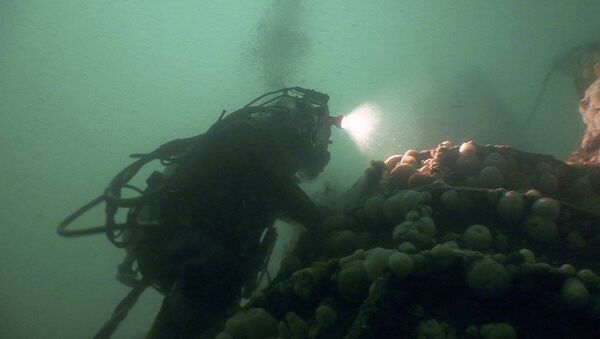The remains of a rare German submarine, which spearheaded the marine technology of its time, has been found in the Skagerrak area off Denmark's coast as part of the Sea War Museum Jutland's work to map and eventually salvage wreckages in the North Sea, Danish TV2 reported.
The German U-3523 submarine, was sunk by a British B-24 Liberator bomber on May 6, 1945, the very day the Allied Forces liberated Denmark from the Nazi German occupation. All 58 crew members died.
The U-3523 wreckage was found close to the Horn of Skagerrak, nine nautical miles away from where it was previously thought to have been sunk, the Sea War Museum Jutland explained.
"This was a very special U-boat. It was the most advanced submarine the Germans built during the [Second World] war. It was highly modern and far ahead of its time," Sea War Museum Jutland director Gert Normann Andersen told TV2.
According to Andersen, 118 of the cutting-edge submarines were ordered, but only two actually made it to the navy and entered service.
Only one preserved example of this submarine class exists, currently on display at the German Maritime Museum at Bremerhaven, Lower Saxony, which was one of Nazi Germany's main submarine bases during WWII and remains one of the nation's pivotal trade ports today.
READ MORE: German WW2 Bunker to Be Conserved by Hypermodern Heritage Center (PHOTO)
According to Andersen, the submarine had previously been used as a training vessel off Wilhelmshaven, another crucial Nazi naval base, but is believed to have also been used in a secret mission, ultimately prevented by the British bombing. The disappearance of the U-3523 has been connected with rumors about some of the leading Nazi bigwigs attempting an escape to South America with fortunes consisting of gold and precious works of art. These rumors keep circulating even these days for lack of conclusive evidence.
"Why they were fleeing, and where they were going, no one knows. So it's exciting in a way," Andersen said.
Despite the fact that the U-3523 may shed some light to this Nazi escape enigma, the Sea War Museum Jutland has no plans to salvage the sunken submarine currently safely sitting at a depth of 123 meters, its fore buried in the seabed.
The diesel-electric U-3523 was ordered in November 1943, completed in December 1944 and entered service in January 1945. It had a maximum surface speed about 30 kilometers per hour and could operate on silent motors due to innovative engineering techniques. With a crew of five officers and about 50 men, it could travel about 28,000 kilometers.
Although produced prematurely and having significant defects, the series contained some revolutionary solutions, being the first submarine to operate primarily submerged. Although never used in real combat due to flaws, the series could potentially spend several days underwater, being a precursor to modern-day submarine warfare.

READ MORE: Sunken Submarine Baffles Norway (and Nope, It's Not Russian)
Sea War Museum Jutland in the coastal town of Thyborøn is currently in the process of a major scan of the seabed for shipwrecks in the North Sea and the Skagerrak Straight. So far 450 wrecks have been located, of them 12 submarines, three British and nine German.






